The Spatial Correlation and Anisotropy of β-(AlxGa1−x)2O3 Single Crystal
Abstract
:1. Introduction
2. Material Growth and Characterization Methods
3. Results and Discussion
3.1. Crystal Structure and Composition
3.2. Raman Scattering Spectroscopy
3.3. Spatial Correlation of Raman Phonons
3.4. In-Plane Anisotropy
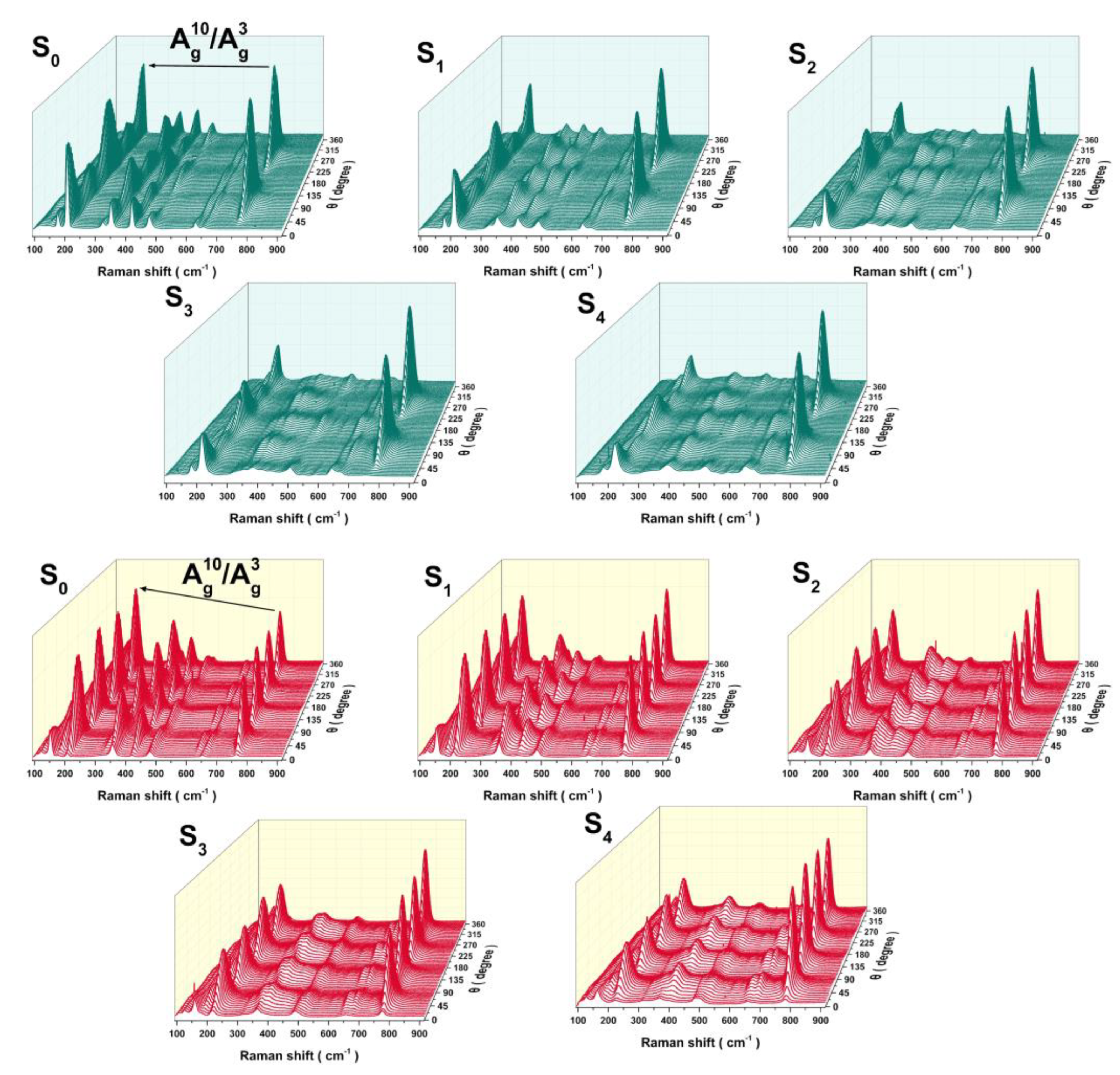
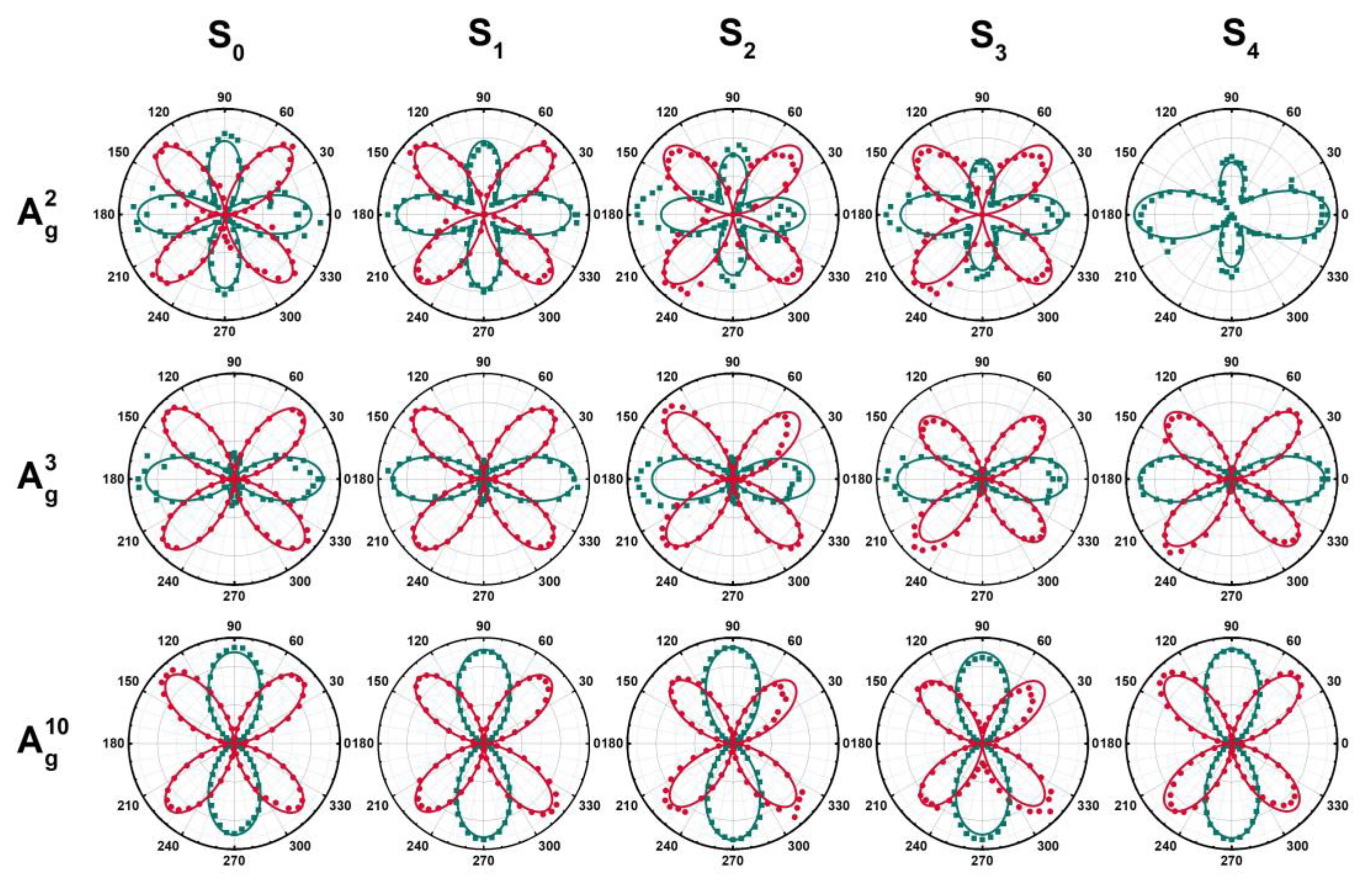
4. Conclusions
Supplementary Materials
Author Contributions
Funding
Institutional Review Board Statement
Informed Consent Statement
Data Availability Statement
Conflicts of Interest
References
- Guo, D.; Guo, Q.; Chen, Z.; Wu, Z.; Li, P.; Tang, W. Review of Ga2O3-based optoelectronic devices. Mater. Today Phys. 2019, 11, 1240–1248. [Google Scholar] [CrossRef]
- Liao, Y.; Zhang, Z.; Gao, Z.; Qian, Q.; Hua, M. Tunable Properties of Novel Ga2O3 Monolayer for Electronic and Optoelectronic Applications. ACS Appl. Mater. Interfaces 2020, 12, 30659–30669. [Google Scholar] [CrossRef] [PubMed]
- Feng, Q.; Li, X.; Han, G.; Huang, L.; Li, F.; Tang, W.; Zhang, J.; Hao, Y. (AlGa)2O3 solar-blind photodetectors on sapphire with wider bandgap and improved responsivity. Opt. Mater. Express 2017, 7, 1240–1248. [Google Scholar] [CrossRef]
- Higashiwaki, M.; Sasaki, K.; Murakami, H.; Kumagai, Y.; Koukitu, A.; Kuramata, A.; Masui, T.; Yamakoshi, S. Recent progress in Ga2O3 power devices. Semicond. Sci. Technol. 2016, 31, 034001. [Google Scholar] [CrossRef]
- Li, J.; Chen, X.; Ma, T.; Cui, X.; Ren, F.-F.; Gu, S.; Zhang, R.; Zheng, Y.; Ringer, S.P.; Fu, L.; et al. Identification and modulation of electronic band structures of single-phase β-(AlxGa1-x)2O3 alloys grown by laser molecular beam epitaxy. Appl. Phys. Lett. 2018, 113, 041901. [Google Scholar] [CrossRef] [Green Version]
- Wang, T.; Li, W.; Ni, C.; Janotti, A. Band Gap and Band Offset of Ga2O3 and (AlxGa1-x)2O3 Alloys. Phys. Rev. Appl. 2018, 10, 011003. [Google Scholar] [CrossRef] [Green Version]
- Zhang, T.; Cheng, Q.; Li, Y.; Hu, Z.; Zhang, Y.; Ma, J.; Yao, Y.; Zuo, Y.; Feng, Q.; Zhang, Y.; et al. Heterogrowth of β-(AlxGa1-x)2O3 Thin Films on Sapphire Substrates. Cryst. Growth Des. 2022, 22, 3698–3707. [Google Scholar] [CrossRef]
- Okumura, H.; Kato, Y.; Oshima, T.; Palacios, T. Demonstration of lateral field-effect transistors using Sn-doped β-(AlGa)2O3 (010). Jpn. J. Appl. Phys. 2019, 58, SBBD12. [Google Scholar] [CrossRef]
- Ghosh, K.; Singisetti, U. Electron mobility in monoclinic β-Ga2O3—Effect of plasmon-phonon coupling, anisotropy, and confinement. J. Mater. Res. 2017, 32, 4142–4152. [Google Scholar] [CrossRef] [Green Version]
- Huang, S.-S.; Lopez, R.; Paul, S.; Neal, A.T.; Mou, S.; Houng, M.-P.; Li, J.V. β-Ga2O3 defect study by steady-state capacitance spectroscopy. Jpn. J. Appl. Phys. 2018, 57, 091101. [Google Scholar] [CrossRef]
- Neal, A.T.; Mou, S.; Lopez, R.; Li, J.V.; Thomson, D.B.; Chabak, K.D.; Jessen, G.H. Incomplete Ionization of a 110 meV Unintentional Donor in beta-Ga2O3 and its Effect on Power Devices. Sci. Rep. 2017, 7, 13218. [Google Scholar] [CrossRef] [PubMed] [Green Version]
- Peelaers, H.; Varley, J.B.; Speck, J.S.; Van de Walle, C.G. Structural and electronic properties of Ga2O3-Al2O3 alloys. Appl. Phys. Lett. 2018, 112, 242101. [Google Scholar] [CrossRef]
- Ma, X.; Zhang, Y.; Dong, L.; Jia, R. First-principles calculations of electronic and optical properties of aluminum-doped β-Ga2O3 with intrinsic defects. Results Phys. 2017, 7, 1582–1589. [Google Scholar] [CrossRef]
- Kim, S.; Ryou, H.; Lee, I.G.; Shin, M.; Cho, B.J.; Hwang, W.S. Impact of Al doping on a hydrothermally synthesized β-Ga2O3 nanostructure for photocatalysis applications. RSC Adv. 2021, 11, 7338–7346. [Google Scholar] [CrossRef] [PubMed]
- Bhuiyan, A.F.M.A.U.; Feng, Z.; Johnson, J.M.; Huang, H.-L.; Sarker, J.; Zhu, M.; Karim, M.R.; Mazumder, B.; Hwang, J.; Zhao, H. Phase transformation in MOCVD growth of (AlxGa1-x)2O3 thin films. APL Mater. 2020, 8, 031104. [Google Scholar] [CrossRef] [Green Version]
- Hilfiker, M.; Kilic, U.; Mock, A.; Darakchieva, V.; Knight, S.; Korlacki, R.; Mauze, A.; Zhang, Y.; Speck, J.; Schubert, M. Dielectric function tensor (1.5 eV to 9.0 eV), anisotropy, and band to band transitions of monoclinic β-(AlxGa1-x)2O3 (x ≤ 0.21) films. Appl. Phys. Lett. 2019, 114, 231901. [Google Scholar] [CrossRef]
- Chen, X.; Niu, W.; Wan, L.; Xia, C.; Cui, H.; Talwar, D.N.; Feng, Z.C. Microstructure and temperature-dependence of Raman scattering properties of β-(AlxGa1-x)2O3 crystals. Superlattices Microstruct. 2020, 140, 106469. [Google Scholar] [CrossRef]
- Kim, S.; Ryou, H.; Moon, J.; Lee, I.G.; Hwang, W.S. Codoping of Al and In atoms in β-Ga2O3 semiconductors. J. Alloys Compd. 2023, 931, 167502. [Google Scholar] [CrossRef]
- Sabino, F.P.; de Oliveira, L.N.; Da Silva, J.L.F. Role of atomic radius and d-states hybridization in the stability of the crystal structure of M2O3(M = Al, Ga, In) oxides. Phys. Rev. B 2014, 90, 155206. [Google Scholar] [CrossRef]
- Janzen, B.M.; Mazzolini, P.; Gillen, R.; Falkenstein, A.; Martin, M.; Tornatzky, H.; Maultzsch, J.; Bierwagen, O.; Wagner, M.R. Isotopic study of Raman active phonon modes in β-Ga2O3. J. Mater. Chem. C 2021, 9, 2311–2320. [Google Scholar] [CrossRef]
- Kranert, C.; Jenderka, M.; Lenzner, J.; Lorenz, M.; von Wenckstern, H.; Schmidt-Grund, R.; Grundmann, M. Lattice parameters and Raman-active phonon modes of β-(AlxGa1-x)2O3. J. Appl. Phys. 2015, 117, 125703. [Google Scholar] [CrossRef] [Green Version]
- Janzen, B.M.; Gillen, R.; Galazka, Z.; Maultzsch, J.; Wagner, M.R. First- and second-order Raman spectroscopy of monoclinic β−Ga2O3. Phys. Rev. Mater. 2022, 6, 054601. [Google Scholar] [CrossRef]
- Schmidt, C.; Zahn, D.R.T. Effect of impurities on the Raman spectra of spray-coated β-Ga2O3 thin films. J. Vac. Sci. Technol. A 2022, 40, 043404. [Google Scholar] [CrossRef]
- Dohy, D.; Lucazeau, G.; Revcolevschi, A. Raman spectra and valence force field of single-crystalline β-Ga2O3. J. Solid State Chem. 1982, 45, 180–192. [Google Scholar] [CrossRef]
- Bhattacharjee, J.; Sagdeo, A.; Singh, S.D. Determination of Al occupancy and local structure for β-(AlxGa1-x)2O3 alloys across nearly full composition range from Rietveld analysis. Appl. Phys. Lett. 2022, 120, 262101. [Google Scholar] [CrossRef]
- Bhattacharjee, J.; Singh, S.D. Observation of mixed-mode behavior of Raman active phonon modes for β-(AlxGa1-x)2O3 alloys. Appl. Phys. Lett. 2023, 122, 112101. [Google Scholar] [CrossRef]
- Krueger, B.W.; Dandeneau, C.S.; Nelson, E.M.; Dunham, S.T.; Ohuchi, F.S.; Olmstead, M.A.; Jones, J. Variation of Band Gap and Lattice Parameters of β-(AlxGa1-x)2O3 Powder Produced by Solution Combustion Synthesis. J. Am. Ceram. Soc. 2016, 99, 2467–2473. [Google Scholar] [CrossRef]
- Khan, T.M. Into the nature of Pd-dopant induced local phonon modes and associated disorders in ZnO; based on spatial correlation model. Mater. Chem. Phys. 2015, 153, 248–255. [Google Scholar] [CrossRef]
- Silva, R.L.d.S.e.; Franco Jr, A. Raman spectroscopy study of structural disorder degree of ZnO ceramics. Mater. Sci. Semicond. Process. 2020, 119, 105227. [Google Scholar] [CrossRef]
- Parayanthal, P.; Pollak, F.H. Raman Scattering in Alloy Semiconductors: “Spatial Correlation” Model. Phys. Rev. Lett. 1984, 52, 1822–1825. [Google Scholar] [CrossRef]
- Dev, G.S.; Sharma, V.; Singh, A.; Baghel, V.S.; Yanagida, M.; Nagataki, A.; Tripathi, N. Raman spectroscopic study of ZnO/NiO nanocomposites based on spatial correlation model. RSC Adv. 2019, 9, 26956–26960. [Google Scholar] [CrossRef] [PubMed] [Green Version]
- Wang, J.; Yao, W.H.; Wang, J.B.; Lu, H.Q.; Sun, H.H.; Wang, X.; Pang, Z.L. Quality of ZnSe/GaAs epilayers studied by spatial correlation model of Raman scattering. Appl. Phys. Lett. 1993, 62, 2845–2847. [Google Scholar] [CrossRef]
- Tiong, K.K.; Amirtharaj, P.M.; Pollak, F.H.; Aspnes, D.E. Effects of As+ ion implantation on the Raman spectra of GaAs: ‘‘Spatial correlation’’ interpretation. Appl. Phys. Lett. 1984, 44, 122–124. [Google Scholar] [CrossRef]
- Farid, S.; Stroscio, M.A.; Dutta, M. Multiphonon Raman scattering and photoluminescence studies of CdS nanocrystals grown by thermal evaporation. Superlattices Microstruct. 2018, 115, 204–209. [Google Scholar] [CrossRef]
- Feng, Z.C. Micro-Raman scattering and microphotoluminescence of GaN thin films grown on sapphire by metal-organic chemical vapor deposition. Opt. Eng. 2002, 41, 2022–2031. [Google Scholar] [CrossRef]
- Liu, Y.B.; Yang, J.Y.; Xin, G.M.; Liu, L.H.; Csanyi, G.; Cao, B.Y. Machine learning interatomic potential developed for molecular simulations on thermal properties of β-Ga2O3. J. Chem. Phys. 2020, 153, 144501. [Google Scholar] [CrossRef]
- Zhang, K.; Xu, Z.; Zhao, J.; Wang, H.; Hao, J.; Zhang, S.; Cheng, H.; Dong, B. Temperature-dependent Raman and photoluminescence of β-Ga2O3 doped with shallow donors and deep acceptors impurities. J. Alloys Compd. 2021, 881, 160665. [Google Scholar] [CrossRef]
- Jin, M.; Zheng, W.; Ding, Y.; Zhu, Y.; Wang, W.; Huang, F. Raman Tensor of van der Waals MoSe2. J. Phys. Chem. Lett. 2020, 11, 4311–4316. [Google Scholar] [CrossRef]
- Talochkin, A.B. Circularly polarized Raman scattering in silicon. J. Raman Spectrosc. 2019, 51, 201–206. [Google Scholar] [CrossRef]
- Shimasaki, M.; Nishihara, T.; Matsuda, K.; Endo, T.; Takaguchi, Y.; Liu, Z.; Miyata, Y.; Miyauchi, Y. Directional Exciton-Energy Transport in a Lateral Heteromonolayer of WSe2-MoSe2. ACS Nano 2022, 16, 8205–8212. [Google Scholar] [CrossRef]
- Zhang, K.; Xu, Z.; Zhao, J.; Wang, H.; Hao, J.; Zhang, S.; Cheng, H.; Dong, B. Anisotropies of angle-resolved polarized Raman response identifying in low miller index β-Ga2O3 single crystal. Appl. Surf. Sci. 2022, 581, 152426. [Google Scholar] [CrossRef]
- Ling, X.; Huang, S.; Hasdeo, E.H.; Liang, L.; Parkin, W.M.; Tatsumi, Y.; Nugraha, A.R.T.; Puretzky, A.A.; Das, P.M.; Sumpter, B.G.; et al. Anisotropic Electron-Photon and Electron-Phonon Interactions in Black Phosphorus. Nano Lett. 2016, 16, 2260–2267. [Google Scholar] [CrossRef] [PubMed]
- Pezzotti, G. Raman spectroscopy of piezoelectrics. J. Appl. Phys. 2013, 113, 211301. [Google Scholar] [CrossRef]
- Kim, S.; Lee, J.; Lee, C.; Ryu, S. Polarized Raman Spectra and Complex Raman Tensors of Antiferromagnetic Semiconductor CrPS4. J. Phys. Chem. C 2021, 125, 2691–2698. [Google Scholar] [CrossRef]

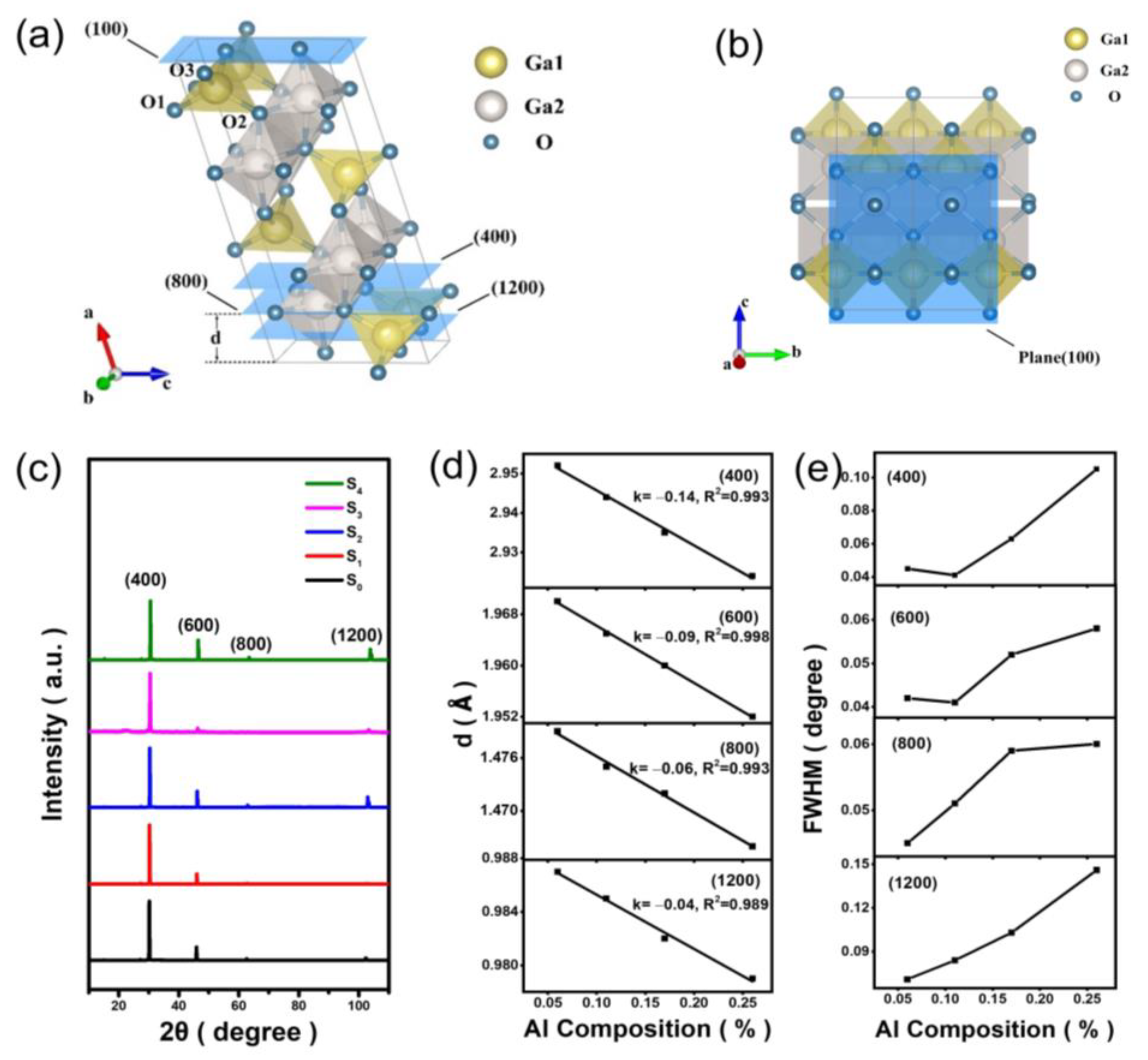

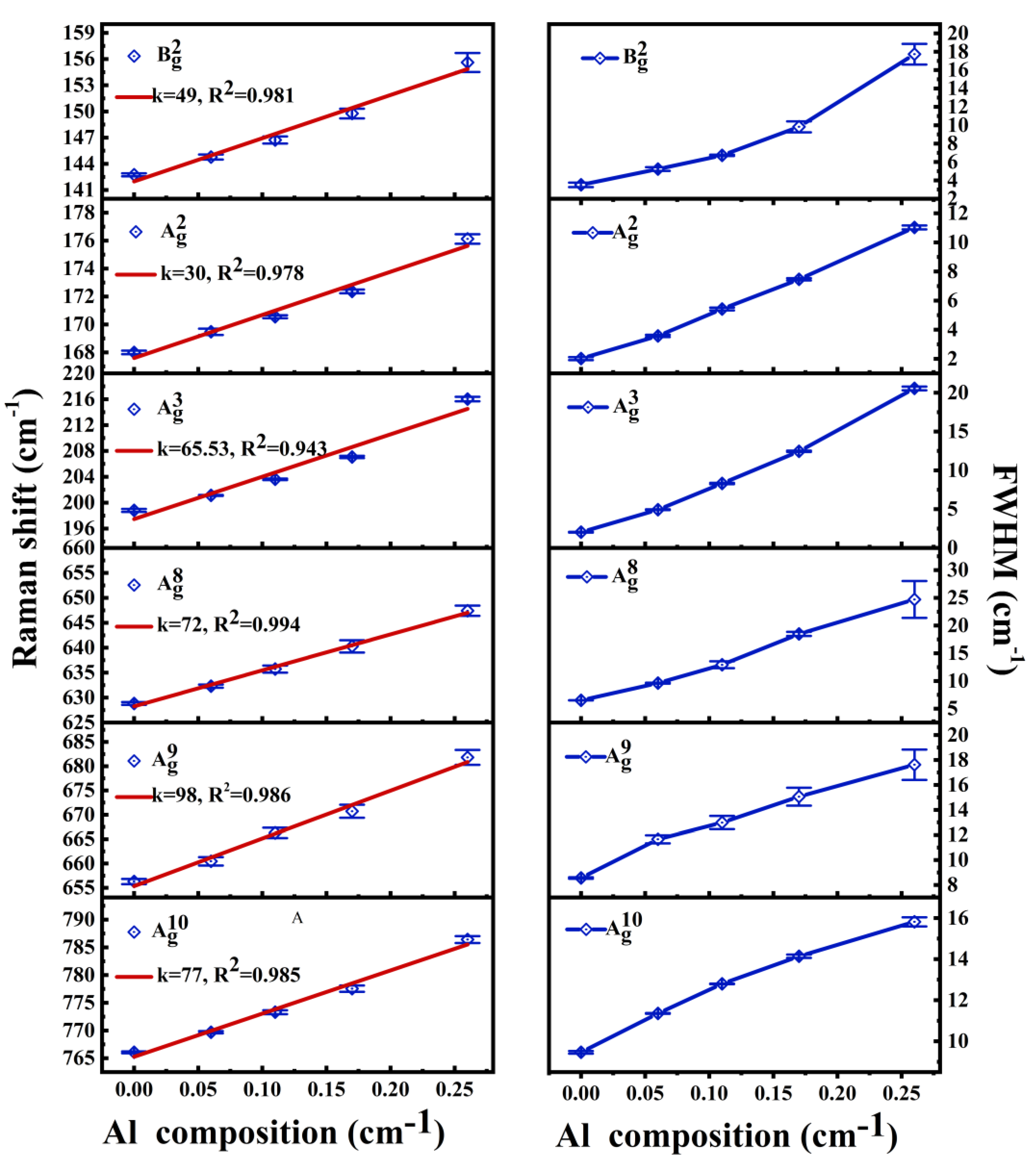
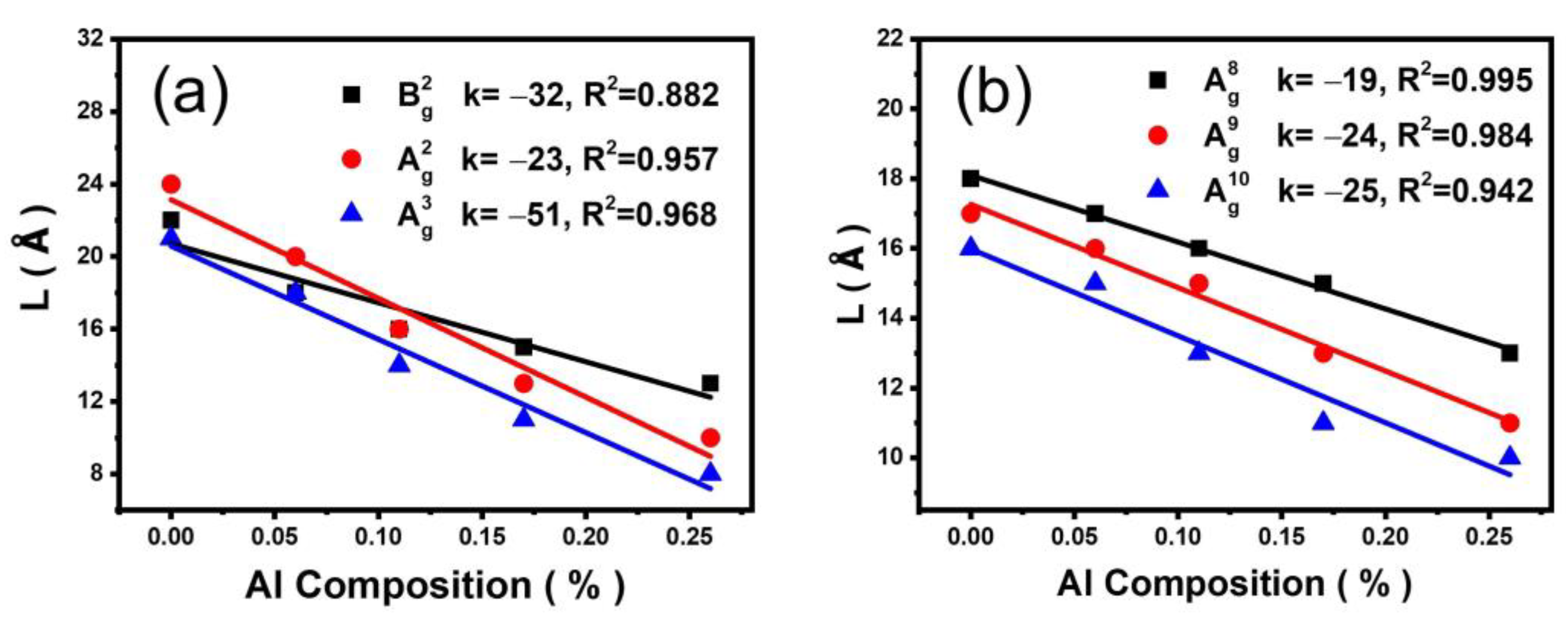
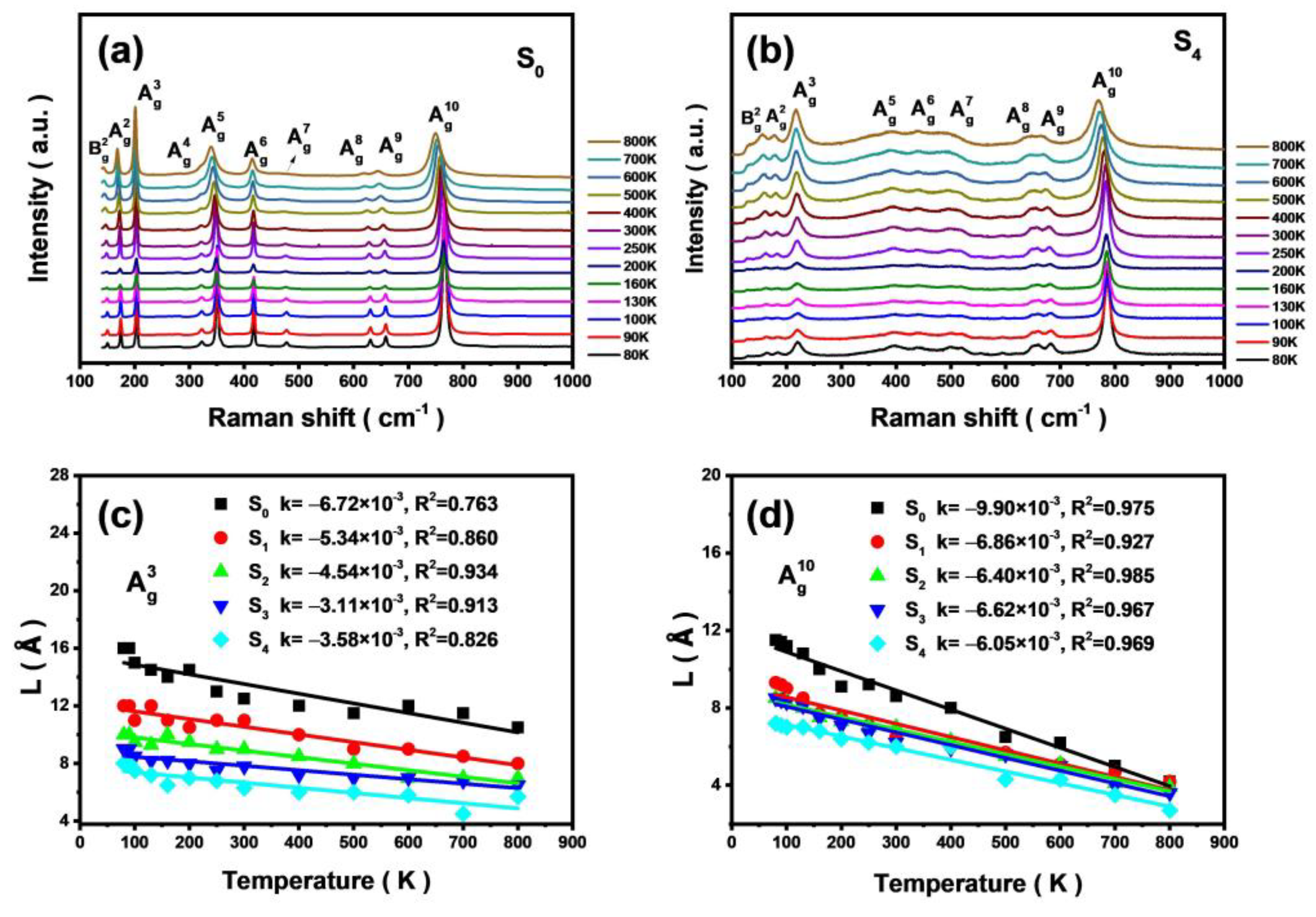
| S0 (At%) | S1 (At%) | S2 (At%) | S3 (At%) | S4 (At%) | |
|---|---|---|---|---|---|
| O K | 57.3 | 56.6 | 56.8 | 57.5 | 65.5 |
| Al L | 0.1 | 2.6 | 4.7 | 7.2 | 8.9 |
| Ga L | 42.4 | 40.8 | 38.5 | 35.3 | 25.5 |
| Al/(Al + Ga) | 0.00 | 0.06 | 0.11 | 0.17 | 0.26 |
| S0 | S1 | S2 | S3 | S4 | |||||||||||
|---|---|---|---|---|---|---|---|---|---|---|---|---|---|---|---|
| |a/c| | φac | R2 | |a/c| | φac | R2 | |a/c| | φac | R2 | |a/c| | φac | R2 | |a/c| | φac | R2 | |
| 0.922 | 0.724 | 0.873 | 0.919 | 0.632 | 0.947 | 0.915 | 0.557 | 0.620 | 0.824 | 0.526 | 0.849 | 0.732 | 0.575 | 0.915 | |
| 0.503 | 0.754 | 0.964 | 0.459 | 0.950 | 0.990 | 0.465 | 0.612 | 0.888 | 0.373 | 0.838 | 0.975 | 0.362 | 1.018 | 0.994 | |
| 14.740 | 0.129 | 0.996 | 14.463 | 0.185 | 0.998 | 13.256 | 0.454 | 0.990 | 12.903 | 0.327 | 0.993 | 11.995 | 0.128 | 0.988 | |
| S0 | S1 | S2 | S3 | S4 | |
|---|---|---|---|---|---|
| parallel polarization | 2.129 | 2.322 | 2.462 | 2.815 | 3.147 |
| cross-polarization | 1.370 | 1.430 | 1.627 | 1.761 | 2.488 |
Disclaimer/Publisher’s Note: The statements, opinions and data contained in all publications are solely those of the individual author(s) and contributor(s) and not of MDPI and/or the editor(s). MDPI and/or the editor(s) disclaim responsibility for any injury to people or property resulting from any ideas, methods, instructions or products referred to in the content. |
© 2023 by the authors. Licensee MDPI, Basel, Switzerland. This article is an open access article distributed under the terms and conditions of the Creative Commons Attribution (CC BY) license (https://creativecommons.org/licenses/by/4.0/).
Share and Cite
Li, L.; Wan, L.; Xia, C.; Sai, Q.; Talwar, D.N.; Feng, Z.C.; Liu, H.; Jiang, J.; Li, P. The Spatial Correlation and Anisotropy of β-(AlxGa1−x)2O3 Single Crystal. Materials 2023, 16, 4269. https://doi.org/10.3390/ma16124269
Li L, Wan L, Xia C, Sai Q, Talwar DN, Feng ZC, Liu H, Jiang J, Li P. The Spatial Correlation and Anisotropy of β-(AlxGa1−x)2O3 Single Crystal. Materials. 2023; 16(12):4269. https://doi.org/10.3390/ma16124269
Chicago/Turabian StyleLi, Liuyan, Lingyu Wan, Changtai Xia, Qinglin Sai, Devki N. Talwar, Zhe Chuan Feng, Haoyue Liu, Jiang Jiang, and Ping Li. 2023. "The Spatial Correlation and Anisotropy of β-(AlxGa1−x)2O3 Single Crystal" Materials 16, no. 12: 4269. https://doi.org/10.3390/ma16124269






